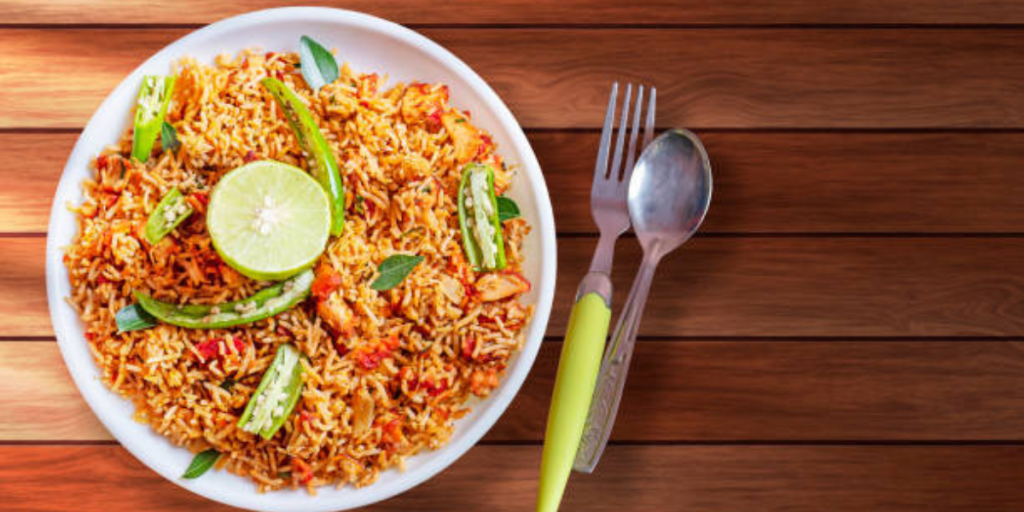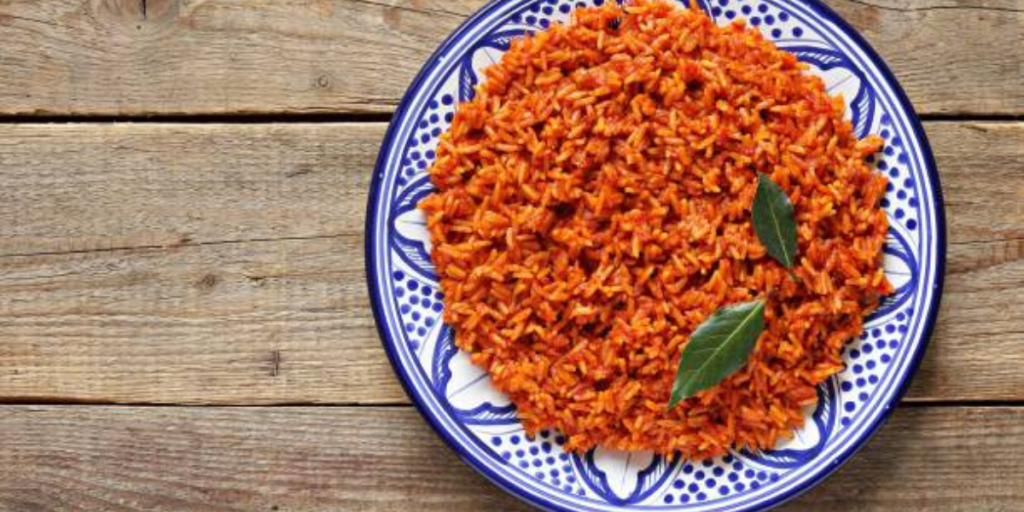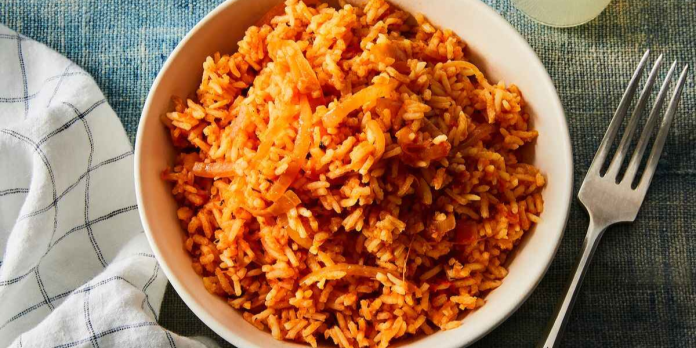Table of Contents

Jollof rice : If you’ve ever attended a Nigerian party, you know that Jollof rice is the star of the show. This beloved dish, with its rich and flavorful taste, brings people together and is a must-have at any celebration. Whether you’re a seasoned cook or a beginner looking to impress your guests, this comprehensive guide will walk you through everything you need to know to make the best Nigerian party Jollof rice.
In this blog post, we’ll delve into the history of Jollof rice, explore the essential ingredients, provide step-by-step cooking instructions, share tips and tricks for perfection, and much more. By the end, you’ll be well-equipped to make a Jollof rice dish that will leave everyone asking for seconds. Don’t forget to comment, like, and bookmark this page for future reference!
Isi Ewu |How To Make Isi Ewu Best Recipe of…
While the origins of Jollof rice can be traced back to the Wolof people, it has been embraced and adapted by various West African countries, each adding its unique touch. In Senegal, the dish is known as “Thieboudienne” and often includes fish and a variety of vegetables. Ghanaian Jollof is known for its use of basmati rice and a slightly different spice mix. Despite these regional variations, the core essence of Jollof rice remains a flavorful, tomato-based rice dish that brings people together.
In Nigeria, Jollof rice has taken on a life of its own. It’s not just a dish; it’s a point of national pride. The “Jollof Wars” between Nigeria and Ghana have sparked playful debates about which country makes the best Jollof rice, highlighting the dish’s cultural significance and the passion it evokes.
Nkwobi and Ugba Nigeria’s Great From The East No 1
Ingredients for the Perfect Party Jollof
Gathering the Essentials: What You Need for Authentic Nigerian Jollof Rice
To create the perfect Nigerian party Jollof rice, you’ll need the following ingredients:
- Rice: Long-grain parboiled rice is preferred for its texture and ability to absorb flavors.
- Tomatoes: Fresh tomatoes and tomato paste provide the rich red color.
- Bell Peppers: Red bell peppers add sweetness and depth.
- Onions: A staple in Nigerian cooking, onions enhance the overall flavor.
- Scotch Bonnet Peppers: These add the necessary heat and spice.
- Garlic and Ginger: Freshly minced garlic and ginger for added aroma.
- Seasonings: Thyme, curry powder, bay leaves, and bouillon cubes.
- Oil: Vegetable oil or palm oil for cooking.
- Stock: Chicken or beef stock to cook the rice.
- Salt and Pepper: To taste.
Choosing the Right Ingredients: Quality Matters
- Rice: The type of rice you use can significantly impact the final dish. Long-grain parboiled rice is preferred because it holds up well to the cooking process and absorbs flavors without becoming mushy.
- Tomatoes and Tomato Paste: Fresh, ripe tomatoes are essential for a rich, vibrant sauce. Tomato paste adds depth and intensifies the color. Look for high-quality tomato paste without added sugars or preservatives.
- Bell Peppers: Red bell peppers add a subtle sweetness that balances the acidity of the tomatoes. They also contribute to the bright red color characteristic of Jollof rice.
- Scotch Bonnet Peppers: These peppers are essential for authentic Nigerian Jollof rice. They bring heat and a distinct flavor that other chili peppers can’t replicate. Adjust the quantity to suit your spice tolerance.
- Onions, Garlic, and Ginger: These aromatics form the flavor base of the dish. Use fresh garlic and ginger for the best results.
- Seasonings: Thyme, curry powder, bay leaves, and bouillon cubes are standard in Nigerian kitchens. These seasonings add layers of flavor and complexity to the dish.
- Oil: Vegetable oil is commonly used, but some recipes call for palm oil, which adds a unique flavor and color.
- Stock: Homemade chicken or beef stock is ideal. It adds a depth of flavor that water can’t provide. If using store-bought stock, choose a low-sodium variety to control the saltiness of the dish.
Step-by-Step Cooking Instructions

Detailed Cooking Guide: Achieving Perfection
1. Prepare the Ingredients:
- Blend the Tomatoes and Peppers: In a blender, combine fresh tomatoes, red bell peppers, Scotch bonnet peppers, and one onion. Blend until smooth. Set aside.
- Mince Garlic and Ginger: Peel and finely mince the garlic and ginger. This step ensures they release maximum flavor when cooked.
- Wash the Rice: Place the rice in a large bowl and rinse under cold water until the water runs clear. This helps to remove excess starch, preventing the rice from becoming sticky.
2. Cook the Base:
- Heat the Oil: In a large, heavy-bottomed pot, heat the oil over medium heat. Add the minced garlic and ginger, and sauté until fragrant, about 1-2 minutes.
- Cook the Tomato Mixture: Pour the blended tomato mixture into the pot. Cook, stirring occasionally, until the mixture reduces and the oil begins to separate from the sauce, about 10-15 minutes.
- Add Tomato Paste: Stir in the tomato paste and cook for another 5 minutes, allowing it to caramelize slightly and deepen the flavor.
3. Season the Sauce:
- Add Seasonings: Sprinkle in thyme, curry powder, and crumbled bouillon cubes. Add bay leaves and stir well to combine.
- Pour in Stock: Add the chicken or beef stock and bring the mixture to a boil. Taste and adjust the seasoning with salt and pepper.
4. Cook the Rice:
- Add the Rice: Pour the washed rice into the pot, making sure it’s evenly distributed. Stir to ensure the rice is well coated with the tomato sauce.
- Simmer: Reduce the heat to low, cover the pot with a tight-fitting lid, and let it simmer. Cook for 30-40 minutes, stirring occasionally to prevent the rice from sticking to the bottom.
- Check for Doneness: After about 30 minutes, check the rice for doneness. The rice should be tender, and the liquid should be fully absorbed. If the rice is still firm, add a little more stock or water, cover, and cook for an additional 5-10 minutes.
5. Final Touches:
- Fluff the Rice: Once the rice is fully cooked, remove the pot from the heat. Let it sit for a few minutes, then fluff the rice with a fork.
- Serve: Serve hot, garnished with extra slices of bell pepper or a sprinkle of chopped fresh herbs.
Pro Tip: To achieve the characteristic smoky flavor of party Jollof rice, allow the rice at the bottom of the pot to develop a slight crust. This technique, known as “bottom pot” or “party rice,” adds a deliciously unique taste.
How To Make Nkwobi With Goat Meat. Best Of 2024
Tips and Tricks for the Best Jollof
Ensuring Success: Common Pitfalls and How to Avoid Them
Use Fresh Ingredients: Fresh tomatoes and peppers give a vibrant taste
.Control the Heat: Adjust the Scotch bonnet peppers to your spice preference.
Proper Rice Washing: Rinse rice thoroughly to prevent it from becoming sticky.
Low and Slow Cooking: Cooking on low heat ensures even cooking and enhances flavor.
Quality Stock: Homemade stock is preferred for richer taste.
- Don’t Rush the Sauce: One of the keys to great Jollof rice is patience. Letting the tomato mixture cook down properly ensures a rich, concentrated flavor. Don’t rush this step.
- Stirring Too Much: While it’s important to stir occasionally to prevent sticking, avoid stirring too frequently. Over-stirring can break the rice grains and make the dish mushy.
- Too Much Liquid: Be cautious with the amount of stock you use. It’s easier to add more liquid if needed than to fix overly wet rice. Start with less and add gradually.
- Right Pot and Heat: Use a heavy-bottomed pot for even heat distribution. Cooking on low heat allows the rice to cook evenly and prevents burning.
- Resting Time: After cooking, let the rice rest for a few minutes. This allows the flavors to meld and makes it easier to fluff the rice.
Nkwobi :The Health Benefits of Nkwobi? Nigeria Best 1
Pairing Jollof Rice with Other Dishes

Creating a Balanced Meal: Complementary Dishes
Fried Plantains (Dodo):
- Ingredients: Ripe plantains, vegetable oil, salt.
- Instructions: Peel and slice the plantains. Heat oil in a frying pan, add the plantain slices, and fry until golden brown. Drain on paper towels and sprinkle with salt.
Moi Moi:
- Ingredients: Black-eyed beans, onions, red bell peppers, Scotch bonnet peppers, oil, seasonings.
- Instructions: Soak and peel the beans, then blend with onions, peppers, and water to form a smooth batter. Season, pour into molds, and steam until firm.
Grilled Chicken:
- Ingredients: Chicken pieces, vegetable oil, garlic, ginger, thyme, curry powder, paprika, salt, pepper.
- Instructions: Marinate the chicken with oil and spices for at least 2 hours. Grill over medium heat until fully cooked, turning occasionally for even grilling.
Nigerian Salad:
- Ingredients: Lettuce, cabbage, carrots, cucumber, tomatoes, boiled eggs, baked beans, salad cream.
- Instructions: Chop the vegetables and hard-boiled eggs. Mix in a bowl, add baked beans, and dress with salad cream.
Zobo Drink:
- Ingredients: Dried hibiscus petals, pineapple peel, ginger, cloves, sugar.
- Instructions: Boil hibiscus petals with pineapple peel, ginger, and cloves. Strain, sweeten with sugar, and chill before serving.
Frequently Asked Questions (FAQs)

More Reader Queries: Deepening Your Understanding
Q1: Why does my Jollof rice turn out mushy?
- A1: Ensure you wash the rice thoroughly and use the right amount of water or stock. Cooking on low heat helps too.
Q2: Can I make Jollof rice ahead of time?
- A2: Yes, Jollof rice tastes even better the next day as the flavors meld together. Store in an airtight container and refrigerate.
Q3: How can I achieve the smoky flavor?
- A3: Allow the rice to slightly burn at the bottom of the pot. Alternatively, cook on an open fire.
Q4: Can I use other types of rice?
- A4: While long-grain parboiled rice is preferred, you can experiment with other types. Adjust cooking times accordingly.
Q5: What if I don’t have Scotch bonnet peppers?
- A5: Substitute with habanero peppers or adjust the spice level with other chili peppers.
Q6: How do I store leftover Jollof rice?
- A6: Store leftover Jollof rice in an airtight container in the refrigerator for up to 3 days. Reheat in the microwave or on the stovetop, adding a splash of water or stock to moisten.
Q7: Can I freeze Jollof rice?
- A7: Yes, you can freeze Jollof rice. Allow it to cool completely before transferring to a freezer-safe container. Freeze for up to 3 months. Thaw in the refrigerator overnight and reheat thoroughly before serving.
Q8: How do I prevent the rice from burning?
- A8: Cook on low heat and use a heavy-bottomed pot to distribute heat evenly. Stir occasionally to prevent sticking. If the rice starts to burn, remove the pot from the heat immediately and transfer the rice to another container.
Q9: What can I do if my Jollof rice is too dry?
- A9: If the rice is too dry, add a small amount of hot water or stock, cover the pot, and let it steam for a few minutes. Fluff the rice before serving.
Q10: Can I make Jollof rice vegetarian or vegan?
- A10: Absolutely! Use vegetable stock instead of chicken or beef stock and skip any meat or fish additions. The rest of the ingredients are naturally plant-based.
Reader Engagement
Sharing is Caring: Engage with the Fudz Community
We hope you enjoyed this comprehensive guide to making the best Nigerian party Jollof rice. We would love to hear from you! Share your experiences, tips, and variations in the comments below. Did you try the recipe? How did it turn out? Don’t forget to like, share, and bookmark this page for future reference. Let’s spread the Jollof love!
At Fudz, we believe in the power of community and shared experiences. Have you tried our Jollof rice recipe? How did it turn out? We’d love to hear from you! Share your tips, modifications, and stories in the comments below. Did you discover a secret ingredient or a new method that works for you? Let’s create a space where we can all learn from each other.
If you enjoyed this post, don’t forget to like it and share it with your friends and family. Bookmark this page so you can easily find it next time you’re in the mood for some delicious Jollof rice. Follow us on social media for more mouth-watering recipes and join the Fudz community today!
Conclusion
The Joy of Cooking: Celebrating Nigerian Jollof Rice
Cooking Jollof rice is more than following a recipe; it’s an experience filled with tradition, flavor, and joy. Whether you’re preparing it for a special occasion or a casual family dinner, this dish has the power to bring people together and create lasting memories.
By using fresh ingredients, taking your time, and adding your personal touch, you can create a Jollof rice dish that’s truly special. We hope this guide has inspired you to try making Jollof rice and to explore the rich culinary traditions of Nigeria.
Thank you for joining us on this culinary journey. We look forward to hearing about your cooking adventures and seeing your delicious creations. Stay tuned for more recipes, tips, and food stories from Fudz!





















